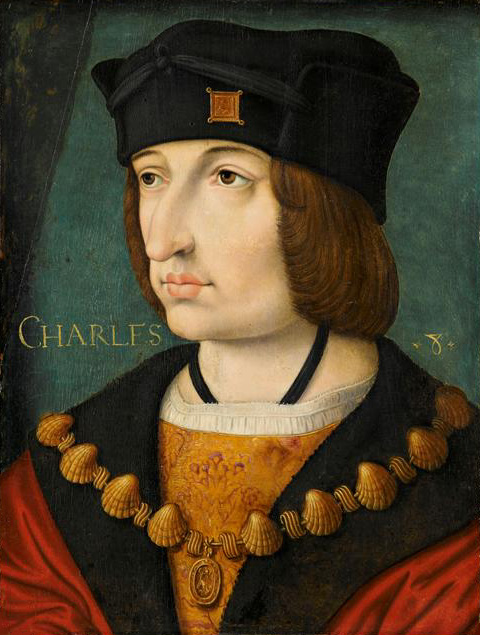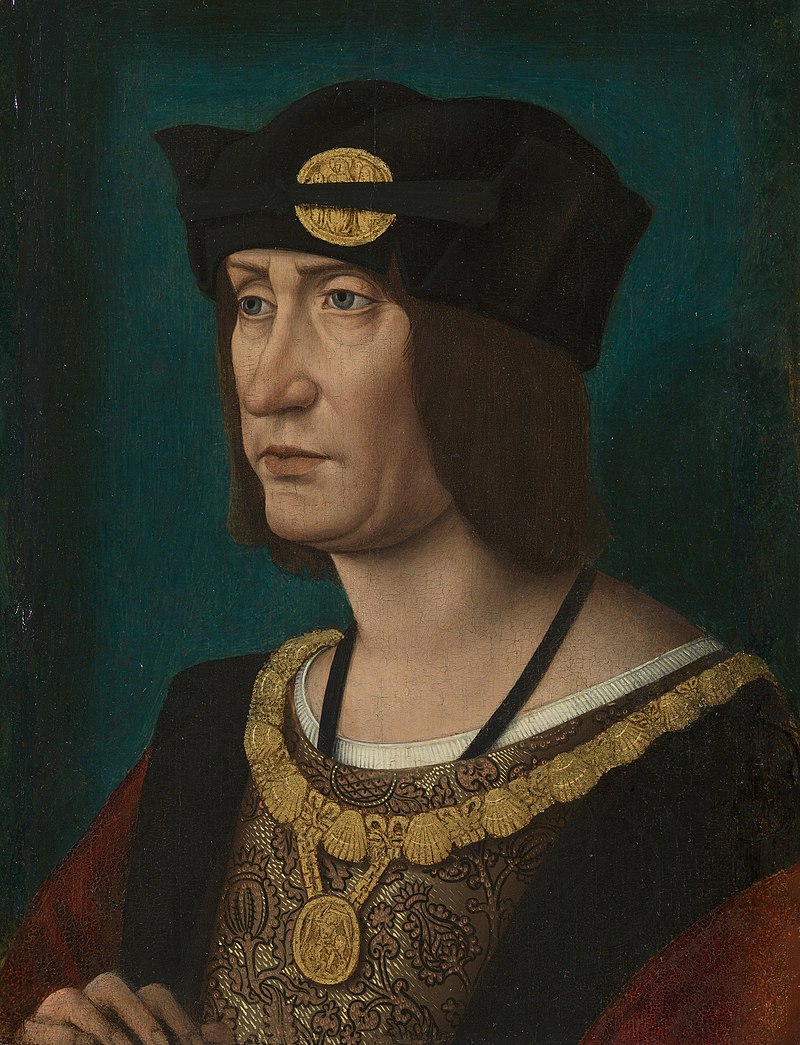by Susan Flantzer
© Unofficial Royalty 2020

Anne at prayer surrounded by Saint Anne, Saint Ursula and Saint Helena by Jean Bourdichon; Credit – Wikipedia
Anne, Duchess of Brittany in her own right, is the only woman to have been Queen Consort of France twice. She was the wife of King Charles VIII of France and the second of the three wives of King Louis XII of France. Born on January 25, 1477, at the Château des ducs de Bretagne (Castle of the Dukes of Brittany) in Nantes, Duchy of Brittany, now in France, Anne was the elder of the two daughters of François II, Duke of Brittany and his second wife Margaret of Foix, Princess of Navarre.
Anne had one younger sister:
- Isabeau of Brittany (1478 – 1490), died at age 12 from pneumonia
Anne had one half-brother from her father’s first marriage to Margaret of Brittany but he died in infancy:
- Jean, Count of Montfort (born and died 1463)
At the age of four, Anne was on track to become Duchess of Brittany and the Queen Consort of England. In 1481, Anne had been officially engaged to Edward, Prince of Wales, the elder son and heir apparent of King Edward IV of England. When his father died in 1483, Edward was briefly King of England as Edward V. The Duke of Gloucester, the future King Richard III, had his nephew Edward V brought to the Tower of London on May 19, 1483, to await his coronation, which never happened. Edward V’s mother Elizabeth Woodville and her children sought sanctuary at Westminster Abbey, fearing the Duke of Gloucester’s further actions. Elizabeth agreed to let her second son Richard, Duke of York leave sanctuary and join his lonely brother at the Tower of London. Meanwhile, Edward and Richard’s uncle the Duke of Gloucester assumed the English throne as King Richard III. Edward and his brother Richard were seen less and less until the end of the summer of 1483 when they disappeared from public view altogether. Their fate is unknown and remains one of history’s greatest mysteries.

Location of the Duchy of Brittany; Credit – Own work, CC BY-SA 4.0, https://commons.wikimedia.org/w/index.php?curid=11234869
The Duchy of Brittany was located on the northwestern peninsula of modern France, bordered by the Atlantic Ocean on the west and the English Channel to the north. The inheritance of the Duchy of Brittany was determined by the 1365 Treaty of Guérande which stated that in the absence of a male heir from the House of Montfort, the heirs of Joanna of Penthièvre, Duchess of Brittany would succeed to the Duchy of Brittany. Anne’s father was the only male from the House of Montfort and the House of Blois-Penthièvre’s heir was also a female, Nicole of Blois, who sold her rights to Brittany to King Louis XI of France. To avoid having the Duchy of Brittany revert to the King of France, Anne’s father had her recognized officially as his heiress by the Estates of Brittany in 1486. This move greatly angered the powers that be in France but increased the competition among the possible husbands for Anne, now a very eligible heiress.
Among the contenders for Anne’s hand in marriage were:
- Henry Tudor: the last male of the House of Lancaster, then in exile in Brittany, but the marriage did not interest him, became King Henry VII of England in 1485.
- Maximilian, King of the Romans and Archduke of Austria: widower of Mary, Duchess of Burgundy in her own right.
- Alain d’Albret, a great-grandson of Jean V, Duke of Brittany, and therefore a possible heir, Anne found him repulsive and refused to consider him.
- Louis, Duke of Orléans (the future King Louis XII of France): the great-grandson of King Charles V of France, the most senior claimant as the heir of King Charles VIII who had no surviving children. However, Louis was already married to Jeanne of France but would have had his loveless, childless marriage annulled to marry Anne.
- Jean de Chalon, Prince of Orange (1443-1502), nephew of Anne’s father François II, Duke of Brittany, and next in line to the Duchy of Brittany after Anne and her sister Isabeau who would die in 1490.
- Edward Stafford, 3rd Duke of Buckingham: the marriage was suggested by King Henry VII of England but Henry VII got a better deal when the executors of the will of Henry Percy, 4th Earl of Northumberland, paid Henry VII £4000 for Buckingham’s marriage to Percy’s eldest daughter Eleanor.

King Charles VIII of France, Anne’s first husband; Credit – Wikipedia
On September 9, 1488, Anne’s father François II, Duke of Brittany died after a fall from his horse, and Anne became the Duchess of Brittany in her own right. Because Anne feared for the independence of her duchy against the might of France, she arranged a marriage for herself with Archduke Maximilian of Austria, the widower of Mary, Duchess of Burgundy in her own right. King Charles VIII succeeded his father as King of France in 1483. However, he was a minor, and his elder sister Anne of France and her husband Peter II, Duke of Bourbon, served as regents. They refused to allow a marriage between Anne and Maximilian because it would put the Habsburgs, Maxililian’s family on two French borders.
A month before Anne’s father died, he had been forced to sign the Treaty of Verger, becoming a vassal of King Charles VIII of France and agreeing to seek Charles’ consent before arranging the marriage of his daughters. The Treaty of Verger was used to force Anne to renounce Archduke Maximilian of Austria, who she had married by proxy, and marry King Charles VIII of France.

Waxwork reenactment of the marriage of Anne, Duchess of Brittany and King Charles VIII of France; Credit – Wikipedia
Anne and King Charles VIII of France were married at the Château de Langeais on December 6, 1491. On February 8, 1492, Anne was crowned Queen of France at the Basilica of Saint-Denis near Paris, France.
Anne and Charles had seven children but none survived:
- Charles Orlando, Dauphin of France (1492 – 1495), died from measles at the age of three
- François (stillborn 1493)
- Stillborn daughter (1494)
- Stillborn daughter (1495)
- Charles, Dauphin of France (September 1496 – October 1496)
- François, Dauphin of France (1497), died several hours after birth
- Anne of France (1498), died several hours after birth

Anne’s second husband, King Louis XII of France; Credit – Wikipedia
King Charles VIII died unexpectedly from a head injury in 1498. Because he had no surviving children, Louis, Duke of Orléans succeeded him as King Louis XII of France. Anne returned to Brittany and began taking steps to ensure the independence of her duchy. Louis XII did not want this to happen and he had his 24-year childless marriage to Charles VIII’s sister Jeanne of France annulled. Louis XII married Anne of Brittany on January 7, 1499, in Nantes, Duchy of Brittany, now in France. They had four stillborn sons and three miscarriages but they did have two daughters who survived to adulthood:
- Princess Claude of France (1499 – 1524), married François d’Angoulême, later King François I of France, had seven children including King Henri II of France and Madeleine of Valois, first wife of James V, King of Scots; only two of Claude’s children lived past the age of 30
- Stillborn son (1500)
- Stillborn son (1503)
- Miscarriage (1503)
- Miscarriage (1505)
- Stillborn son (1508)
- Miscarriage (1509)
- Princess Renée of France (1510 – 1574), married Ercole II, Duke of Ferrara, had five children
- Stillborn son (1512)

Anne receiving a book in praise of famous women, by Jean Perréal, circa 1506; Credit – Wikipedia
Weakened by sixteen pregnancies in twenty years, 36-year-old Anne, Queen of France, Duchess of Brittany died from a kidney stone attack on January 9, 1514, at the Château de Blois in Blois, France. Claude succeeded her mother as Duchess of Brittany. Since Claude’s husband François d’Angoulême became King of France after the death of his father-in-law King Louis XII, the Duchy of Brittany would remain united with the French crown. After Anne’s death, the 52-year-old Louis XII, still seeking a son to succeed him, married 18-year-old Mary Tudor, the younger sister of King Henry VIII of England, but Louis XIII died three months after the marriage.
Anne’s funeral services lasted forty days, becoming the tradition of French royal funerals until the 18th century. Following Anne’s request, her heart was placed in a gold reliquary, then transported to Nantes to be deposited in her parents’ tomb at Nantes Cathedral in the Duchy of Brittany, now in France. During the French Revolution, the gold reliquary containing Anne’s heart was removed from its place of rest, emptied, and sent to Paris to be melted down. Instead, the gold reliquary was kept intact at the National Library in Paris. In 1819, the reliquary was returned to Nantes where it was kept in several museums. Since 1896, the reliquary has been in the collection of the Musée Dobrée in Nantes. On April 13, 2018, the reliquary was stolen from the Musée Dobrée but was recovered undamaged later that month. The inscription on the reliquary reads: “In this little vessel of fine gold, pure and clean, rests a heart greater than any lady in the world ever had. Anne was her name, twice queen in France, Duchess of the Bretons, royal and sovereign.”

Anne’s heart reliquary on display at the Musée Dobrée; Credit – By Picture by –Jibi44 13:18, 31 March 2006 (UTC) – Self-photographed, CC BY-SA 3.0, https://commons.wikimedia.org/w/index.php?curid=662433
Anne and Louis XII were buried at the Basilica of Saint-Denis near Paris in a magnificent tomb carved from Carrara marble by the Juste Family, a family of Italian sculptors. The tomb was commissioned in 1515, probably by Louis XII’s successor King François I of France who was married to Louis and Anne’s elder daughter Claude. Anne and Louis’ tomb has survived although it was desecrated in October 1793 during the French Revolution and their bodies were thrown into a mass grave. However, the archaeologist Alexandre Lenoir saved much of the tomb and preserved it at the Museum of French Monuments. During the Second Bourbon Restoration (1815 – 1830), the tomb was returned to the Basilica of Saint-Denis where it can be seen today.

Tomb of King Louis XII of France and his second of three wives Anne, Queen of France, Duchess of Brittany; Credit – By Photo: Myrabella / Wikimedia Commons, CC BY-SA 3.0, https://commons.wikimedia.org/w/index.php?curid=18611160
This article is the intellectual property of Unofficial Royalty and is NOT TO BE COPIED, EDITED, OR POSTED IN ANY FORM ON ANOTHER WEBSITE under any circumstances. It is permissible to use a link that directs to Unofficial Royalty.
France Resources at Unofficial Royalty
Works Cited
- En.wikipedia.org. 2020. Anne Of Brittany. [online] Available at: <https://en.wikipedia.org/wiki/Anne_of_Brittany> [Accessed 5 June 2020].
- Flantzer, Susan, 2016. King Edward V Of England. [online] Unofficial Royalty. Available at: <https://www.unofficialroyalty.com/king-edward-v-of-england/> [Accessed 5 June 2020].
- Flantzer, Susan and McMahon, Emily, 2013. Louis XII, King Of France. [online] Unofficial Royalty. Available at: <https://www.unofficialroyalty.com/june-27-daily-featured-royal-date/> [Accessed 5 June 2020].
- Fr.wikipedia.org. 2020. Anne De Bretagne. [online] Available at: <https://fr.wikipedia.org/wiki/Anne_de_Bretagne> [Accessed 5 June 2020].
- Fr.wikipedia.org. 2020. François II De Bretagne. [online] Available at: <https://fr.wikipedia.org/wiki/Fran%C3%A7ois_II_de_Bretagne> [Accessed 5 June 2020].
- Fr.wikipedia.org. 2020. Louis XII. [online] Available at: <https://fr.wikipedia.org/wiki/Louis_XII> [Accessed 5 June 2020].
